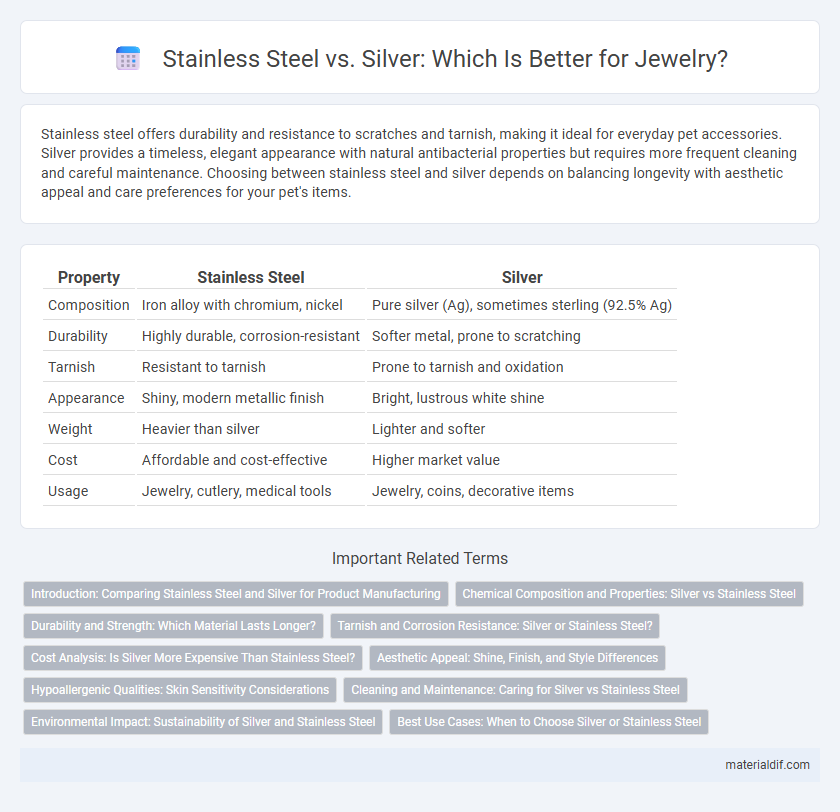Stainless steel offers durability and resistance to scratches and tarnish, making it ideal for everyday pet accessories. Silver provides a timeless, elegant appearance with natural antibacterial properties but requires more frequent cleaning and careful maintenance. Choosing between stainless steel and silver depends on balancing longevity with aesthetic appeal and care preferences for your pet's items.
Table of Comparison
| Property | Stainless Steel | Silver |
|---|---|---|
| Composition | Iron alloy with chromium, nickel | Pure silver (Ag), sometimes sterling (92.5% Ag) |
| Durability | Highly durable, corrosion-resistant | Softer metal, prone to scratching |
| Tarnish | Resistant to tarnish | Prone to tarnish and oxidation |
| Appearance | Shiny, modern metallic finish | Bright, lustrous white shine |
| Weight | Heavier than silver | Lighter and softer |
| Cost | Affordable and cost-effective | Higher market value |
| Usage | Jewelry, cutlery, medical tools | Jewelry, coins, decorative items |
Introduction: Comparing Stainless Steel and Silver for Product Manufacturing
Stainless steel offers superior durability and corrosion resistance compared to silver, making it ideal for high-wear product manufacturing. Silver provides unmatched aesthetic appeal and excellent thermal and electrical conductivity, valued in luxury and decorative items. Choosing between stainless steel and silver depends on balancing cost, functionality, and design requirements specific to the product.
Chemical Composition and Properties: Silver vs Stainless Steel
Silver is a pure metal with a chemical symbol Ag, known for its high electrical and thermal conductivity, extreme malleability, and resistance to oxidation, making it valuable in jewelry and electronics. Stainless steel is an alloy primarily composed of iron, chromium (typically 10.5% or more), and varying amounts of nickel and carbon, offering superior strength, corrosion resistance, and durability compared to silver. Unlike silver, stainless steel forms a passive oxide layer that prevents rust, making it ideal for structural and everyday use, while silver's softness limits its mechanical applications despite its superior conductivity.
Durability and Strength: Which Material Lasts Longer?
Stainless steel offers superior durability and strength compared to silver, making it more resistant to scratches, dents, and corrosion over time. Silver, while valued for its aesthetic appeal and tarnish resistance with proper care, is softer and more prone to wear and deformation. For items subjected to daily use or harsh environments, stainless steel lasts significantly longer due to its robust alloy composition and corrosion-resistant properties.
Tarnish and Corrosion Resistance: Silver or Stainless Steel?
Stainless steel offers superior corrosion resistance compared to silver, making it less prone to tarnish and ideal for everyday wear. Silver, especially sterling silver, tends to oxidize and develop a surface tarnish when exposed to air and moisture over time. For applications demanding long-lasting shine and minimal maintenance, stainless steel is the preferred choice due to its durable, rust-resistant properties.
Cost Analysis: Is Silver More Expensive Than Stainless Steel?
Silver typically carries a higher cost compared to stainless steel due to its precious metal status and intrinsic value on the commodities market. Stainless steel, an alloy primarily composed of iron, carbon, and chromium, is more affordable because it is mass-produced and widely available. The price difference is further influenced by factors such as purity, design complexity, and market demand for silver jewelry and industrial applications.
Aesthetic Appeal: Shine, Finish, and Style Differences
Stainless steel offers a sleek, modern shine with a polished or brushed finish that resists tarnishing and scratches, making it ideal for contemporary, minimalist styles. Silver exhibits a bright, lustrous finish with a warm, reflective glow that develops a natural patina over time, adding character and vintage appeal. The choice between stainless steel and silver depends on preference for durability versus classic elegance in jewelry and decorative items.
Hypoallergenic Qualities: Skin Sensitivity Considerations
Stainless steel is highly regarded for its hypoallergenic properties, making it ideal for individuals with sensitive skin or metal allergies. Silver, particularly sterling silver, contains copper and other alloys that may cause allergic reactions or skin irritation in some people. Choosing stainless steel jewelry minimizes the risk of contact dermatitis due to its nickel-free or low-nickel composition and corrosion resistance.
Cleaning and Maintenance: Caring for Silver vs Stainless Steel
Silver requires regular polishing with a non-abrasive cloth and specialized silver cleaner to prevent tarnish caused by sulfur compounds in the air. Stainless steel, known for its corrosion resistance, can be cleaned easily with mild soap and water or stainless steel-specific cleaners, maintaining its shine without frequent polishing. Proper storage in anti-tarnish bags or cloths is essential for silver to prolong its luster, while stainless steel is more resistant to scratches and everyday wear.
Environmental Impact: Sustainability of Silver and Stainless Steel
Silver mining often results in significant environmental degradation due to habitat destruction and the release of toxic chemicals, whereas stainless steel production, though energy-intensive, benefits from high recyclability and longevity. Stainless steel's durability reduces the need for frequent replacement, lowering overall resource consumption and carbon footprint. Silver's recyclability is notable but less efficient, making stainless steel a more sustainable choice in terms of environmental impact over its lifecycle.
Best Use Cases: When to Choose Silver or Stainless Steel
Silver is ideal for jewelry and decorative items requiring a lustrous finish and hypoallergenic properties, making it perfect for sensitive skin and elegant occasions. Stainless steel excels in durability and corrosion resistance, suitable for everyday wear, kitchenware, and industrial applications where strength and low maintenance are priorities. Choosing silver enhances aesthetic appeal and prestige, while stainless steel offers practicality and long-lasting performance in demanding environments.
Stainless Steel vs Silver Infographic

 materialdif.com
materialdif.com